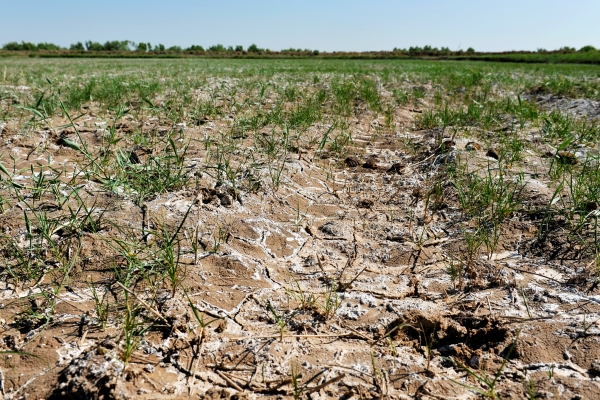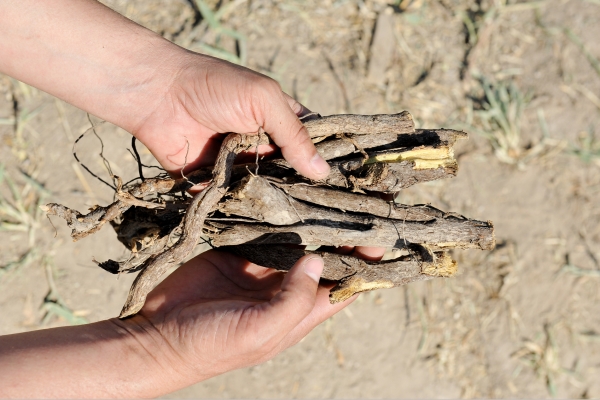World losing 2,000 hectares of irrigated farmland a day
Around one-fifth of irrigated land is now degraded by salt, threatening crop production in 75 countries, according to new research published today by the United Nations, with contributions from scientists at the International Water Management institute (IWMI).[pullquote type=”pullquote5″ content=”The startling rate at which the world is losing productive agricultural land to salt damage is testament to the scale of the challenge we face in managing water efficiently” quote_icon=”yes” align=”right” textcolor=”#009419″]The startling rate at which the world is losing productive agricultural land to salt damage is testament to the scale of the challenge we face in managing water efficiently[/pullquote]
The problems is so severe the world has been losing 2,000 hectares of irrigated land in arid and semi-arid areas every day for the last 20 years, with an area the size of France now affected.
Soil salinity often occurs in arid and semi-arid areas where rainfall is too low to maintain percolation of rainwater through the soil, and where irrigation is practiced without natural or artificial drainage systems. This can trigger the accumulation of salt in the soil, which can cripple yields and in extreme circumstances result in the complete abandonment of the land.

“The startling rate at which the world is losing productive agricultural land to salt damage is testament to the scale of the challenge we face in managing water efficiently,” said Andrew Noble, head of the CGIAR Research Program on Water, Land and Ecosystems (WLE), one of the authors of the paper.
“if we’re going to have any chance of feeding a projected world population of 9 billion people by 2050, and protecting the vital ecosystems that support farming and human livelihoods more broadly, we have to make drastic changes to the way in which we manage and use water for agriculture in order to ensure that we create sustainable irrigated production systems.”
The study, Economics of Salt-induced Land Degradation and Restoration is published Tuesday Oct. 28 in the UN Sustainable Development journal, Natural Resources Forum. It was produced by the United Nations University’s Canada-based Institute for Water, Environment and Health.
[pullquote type=”pullquote5″ content=”From our years of research in salt-affected areas of Central Asia, there appear to be some options for reversing the situation and restoring the soil” quote_icon=”yes” align=”right” textcolor=”#009419″]From our years of research in salt-affected areas of Central Asia, there appear to be some options for reversing the situation and restoring the soil[/pullquote]
The study details crop productivity losses at farm, regional, and global scales, the cost of doing nothing, and the net economic benefit of preventing and/or reversing land degradation. The estimated cost of crop losses was drawn from a review of more than 20 studies over the last 20 years in Australia, India, Pakistan, Spain, Central Asia and the USA.
It also highlights methods successfully used to facilitate drainage and reverse soil degradation: Tree planting, deep plowing, cultivation of salt-tolerant varieties of crops, mixing harvested plant residues into topsoil, and digging a drain or deep ditch around the salt-affected land.
Reversing land degradation and bringing salt-affected lands back into highly productive state are expected to result in favorable environmental benefits in addition to economic gains, although functional markets for many of the ecosystem services are currently embryonic or nonexistent.
Although there is a cost associated with preventing land degradation, reversing land degradation, or restoring degraded land into productive land, it is much lower than the cost of letting land degradation continue and intensify.

“From our years of research in salt-affected areas of Central Asia, there appear to be some options for reversing the situation and restoring the soil,” continued Noble. “One is the planting of salt-tolerant licorice, which over the course of a few years can help nurse the soil back to health, allowing farmers to plant staple crops again. It only costs around USD$60 to restore one hectare of land with licorice, and you only have to wait three-to-four years to see the results.
“Investing in restoring degraded land like this makes much more sense than opening up new agricultural land because in most cases the systems are already in place to get water to the land and move the product to market; all you have to do is rehabilitate the land.”
In Summary:
[fancy-ul style=”arrow-type3-list” variation=”blue”]
- Globally, irrigated lands cover some 310 million ha, an estimated 20% of it salt-affected (62 million ha). The inflation-adjusted cost of salt-induced land degradation in 2013 was estimated at $441 per hectare, yielding an estimate of global economic losses at $27.3 billion per year.
- In India’s Indo-Gangetic Basin, crop yield losses on salt-affected lands for wheat, rice, sugarcane and cotton grown on salt-affected lands could be 40%, 45%, 48%, and 63%, respectively. Employment losses could be 50-80 man-days per hectare, with an estimate 20-40% increase in human health problems and 15-50% increase in animal health problems.
- In the Indus Basin in Pakistan, wheat grain yield losses from salt-affected lands ranged 20-43% with an overall average loss of 32%. For rice, the crop yield losses from salt-affected lands ranged 36-69% with an overall average loss of 48%.
- Even in the USA’s Colorado River Basin, studies show the annual economic impact of salt-induced land degradation in irrigated areas at US $750 million.
[/fancy-ul]
[hr top=”yes”/]
The contributions by IWMI co-authors Pay Drechsel and Andrew Noble were supported by the CGIAR Research Program on Water, Land and Ecosystems.

